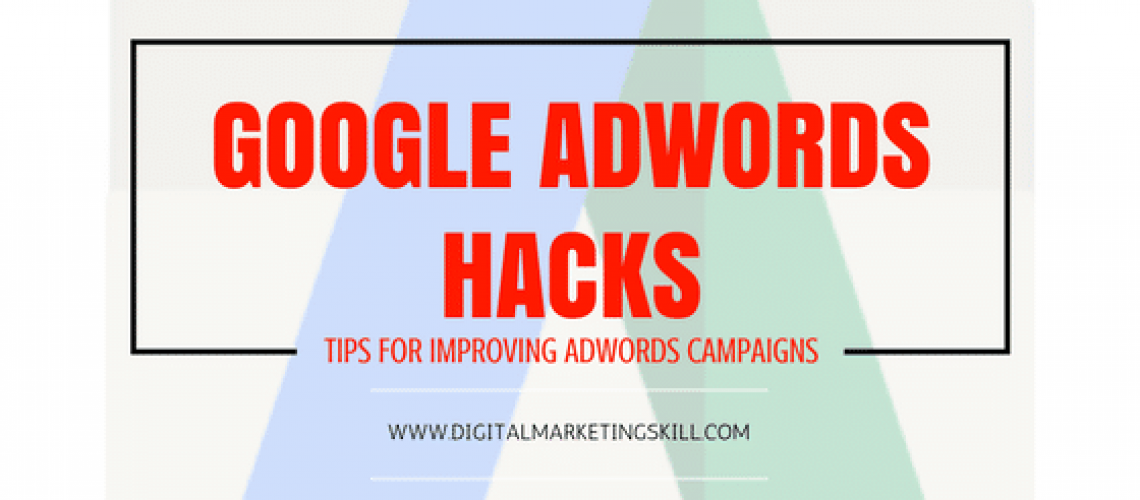Adwords is an amazing source of generating leads for small businesses, but it can also be a complicated system that takes great understanding and hacks to build success with.
Many of the clients that come to Digital Marketing Giant are small and mid-sized business owners who originally created a Google AdWords campaign on their own.
Unfortunately:
When their AdWord campaign failed to produce the required results — and their money had all been wasted, they were left wondering what went wrong.
To that end, there are certain reasons why their AdWords campaign failed, there are reasons why they weren’t able to drive the right customers to their landing pages.
And one of the reason is…
They didn’t accurately optimise their campaigns to increase CTR and conversion.
Get 50% Discount to Master ALL Aspects of Digital Marketing That Can Earn You $2,500 - $5,000 a month (Even if you are a complete beginner!)
Our students that intentionally implement what they learn from our digital marketing course make back the entire course fee within a single month or more after completing our course because our course gives them many income generating options with unlimited earning potential with no age or location barrier. The best part is no technical skills are required.
An opportunity to change your lifestyle and make money working from anywhere in the world. The results our students get from our digital marketing course prove this could be applied to any market or country and that it is designed for any skill level and work background.
*By signing up, you agree to our privacy policy and terms of service.
Even though:
Google makes it incredibly easy to get started with AdWords — just enter your credit card info, pick some keywords, insert them into an ad, and you’re off!
However, no successful campaign was ever created in just a few minutes.
So, I’ve put together 12 ways how to improve your AdWord campaign performance.
![]()
Tips For Improving Your AdWords Campaign Performance
1. Write Compelling Advert Copy
It sounds simple, but unless you take the time to write engaging adverts that include strong calls to action your advert performance will be average at best.
Take a look at your competitors’ ads and try to write advert copy that stands out from the competition.
Think about your business’s unique selling points and experiment by split testing at least two adverts in every AdGroup.
2. Check Your Dimensions Tab For Bid Adjustment Opportunities
If you have been managing your AdWords account for 2 to 3 months and have more than 100 conversions, then you’re most likely going to have a lot of data that will allow you to make more strategic optimisations.
Bid adjustment is an optimisation that you can execute rather quickly.
You have the chance to adjust your bidding dynamically depending on what time of day or day of the week it is. This will allow you to dynamically change your bidding according to your conversion data for any given hour or day combination.
3. Lower Bidding For Keywords With Conversion Costs Above Your Benchmark
A quick filter in your AdWords account can help you reduce the spend that your unprofitable keywords have.
If you look at the last 28 days (or since you last optimized your bids) you’ll be able to find all unprofitable keywords. To do this I recommend the two following filters:
Find all keywords with a cost per conversion higher than your upper limit:
With this filter, we can quickly find all keywords that have a cost per conversion of more than $100 (the limit in this account). Depending on the cost per conversion we can then reduce the bidding with 10, 20 or 30%.
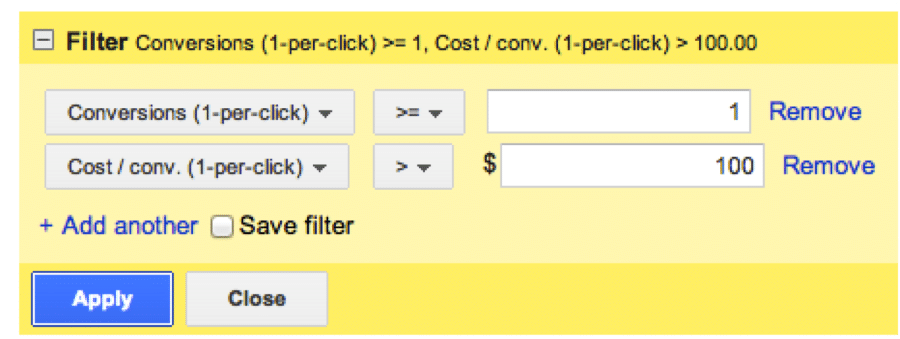
Find all keywords with high costs, but no conversions:
The former example only found keywords with a cost per conversion higher than $100. You’ll, however, most likely have keywords that cost you a lot of money but doesn’t convert at all.
To find these you need this filter:
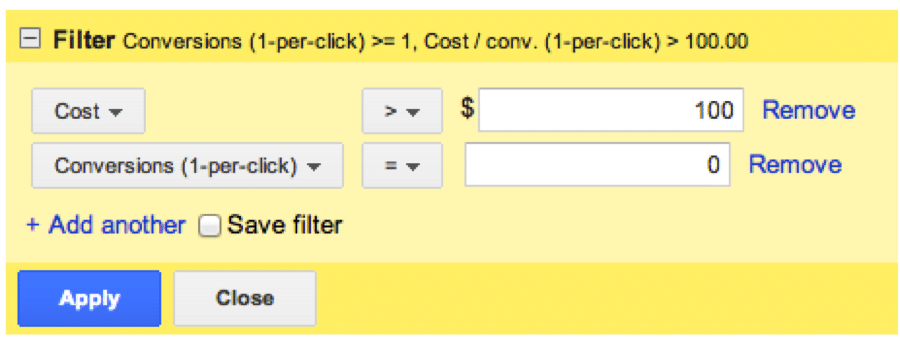
The filter will now show all keyword with no conversions, but a high ad spend. These should either be analyzed to find out why they’re not converting or excluded from your campaign at the current time.
4. Pause Underperforming Keywords
Regularly check the performance of keywords for each of your campaigns.
In the early stages of a campaign, this should be done every day.
Once things are under control, you can scale it back to 2 to 3 times per week. Watch out for keywords that are attracting traffic but not conversions, or keywords with high bounce rates.
You’re paying for those clicks so if they’re not turning into leads or sales, pause those keywords right away!
5. Include Your Target Keywords in Your Adverts
It sounds obvious, but if your adverts don’t include the keywords you are bidding on within your advert copy then your CTRs will be poor and you will potentially pay more than you need to.
Include your target keyword in the headline and again within the ad copy and again in the display URL.
6. Create Minor Variations of Already Successful Ad Copy
It can be hard to always find time to think of brand new ads that you honestly believe have a better chance of converting clicks than your current Champion ad.
Throughout the years I have developed an approach for when my colleagues or I are short of time.
Instead of changing the entire ad I’ll just go ahead and make a minor change to a word or change the order of the two description lines.
You’ll sometimes see that even the smallest changes can have an impact on your AdWords performance.
So the next time you’re dreading the task of creating new ads try to just change a couple of words. This will give you some data to work with next time and possibly a nice little increase in conversion rate.
I’ve often seen that getting a small increase also helps morale and will inspire you to write new and even better ads.
7. Expand Your Keyword List
When you notice keywords that are driving quality traffic and conversions on a regular basis, consider expanding them from Exact Match to Broad Match.
This will allow your ad to appear for more search phrases, which should mean getting more traffic.
If you do expand to Broad Match, make sure you keep an eye on which phrases are sending traffic.
When you see any that are irrelevant to your business, add them to your negative keywords list by going to the Keywords tab in AdWords, selecting All from the Details drop-down menu and selecting the irrelevant keywords before clicking Add as negative keyword.
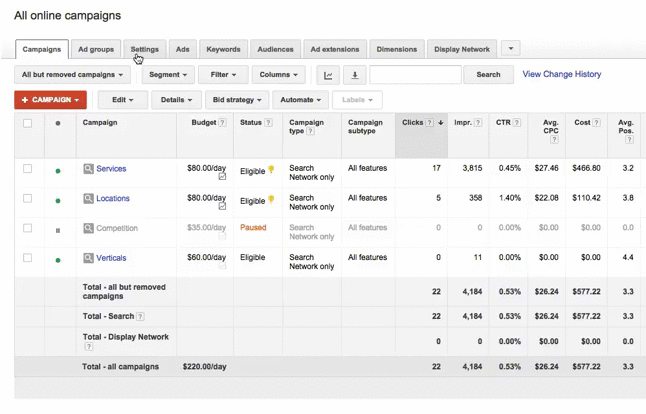
8. Use Negative Remarketing Lists
Remarketing is an extremely powerful way to acquire users.
A past website visitor has a higher chance of clicking on your ad, and convert than a “cold” user.
Using remarketing is absolutely a must for advertisers, and using negative remarketing is something most advertisers simply don’t think about, but definitely should.
With negative remarketing, you exclude users who visited your site, but most likely were not interested in your product or offer.
For example, exclude the people who visited your jobs page. If they were browsing through it, they are certainly not interested in becoming a customer.
Excluding remarketing lists is a very simple thing to do that will make sure your ads are displayed to relevant people, who were really interested in your product or offer.
Exclude the people who visited your Jobs or other irrelevant pages, and certainly exclude your existing customers (unless you are advertising a specific offer for them)
9. Use RLSA In Separated Campaigns
RLSA stands for “remarketing lists for search ads”. Basically, RLSA is remarketing lists that can be used to target past visitors when they are back searching for relevant search queries.
In most cases, advertisers use RLSA in the original search campaigns and ad groups and setting higher bid adjustments for users who are a part of the RLSA list.
This is a great strategy that is definitely worth using, but there’s a way to improve it even more.
Try splitting your search campaigns to cold audience and RLSA. Exclude the RLSA lists from the cold audience campaigns, and target them in the RLSA campaigns.
The downside of splitting RLSA into different campaigns is that it requires much more day to day maintenance. The benefits are that it enables you to fully control your RLSA bids (which should definitely be higher, since returning users are worth a higher bid), and you will be able to write your ads in a different way since these users are already familiar with you.
10. Create Tightly Themed Keyword Groups
All the options in the Google AdWords interface are designed to encourage you to add multiple keywords into your account and into your Ad Groups.
The problem with this is that having 20+ keywords in an AdGroup impacts on the relationship between advert text and keywords in each adgroup.
When people search for a keyword in your Adgroup containing 20+ keyword, the advert that appears will more likely than not, not contain the keyword they are searching for. The end result is that the click-through rates and quality scores of your keywords and adverts are adversely affected.
The solution is the tightly group themes or keywords into smaller groups and make sure that the advert copy contains the keywords at least twice if possible.
11. Don’t Bid On Competitors Names (unless they bid on yours)
It is very common in AdWords that competing brands are targeting each other’s brand names as keywords to “steal” customers. It might seem to make sense, but actually, the only winner here is Google!
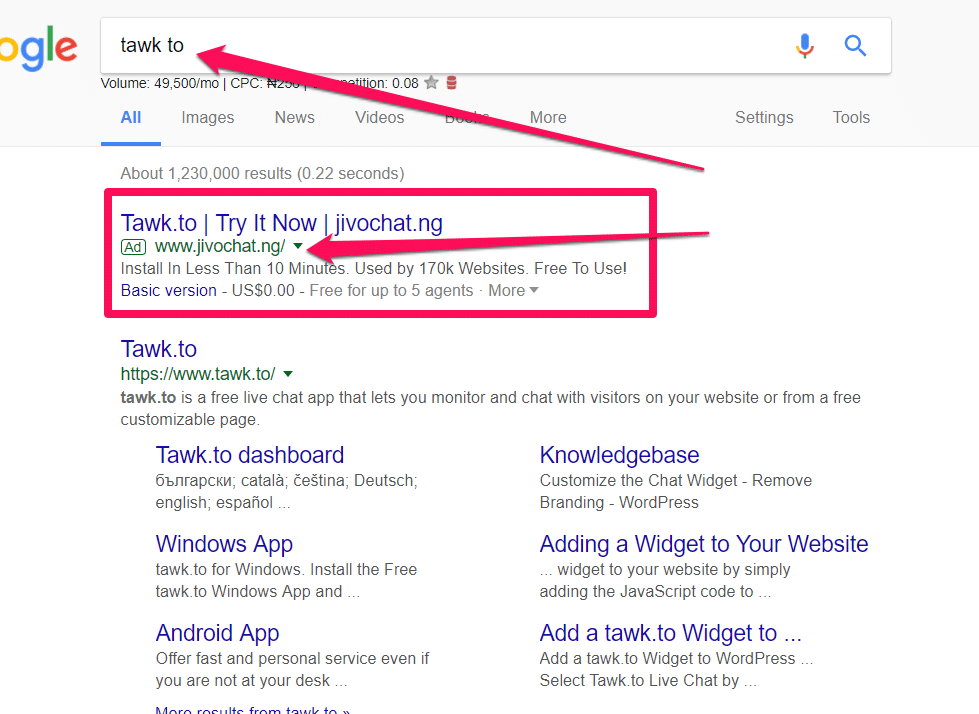
The screenshot shows Jivochat live messaging platform targeting Tawkto keyword (this is another live chat platform).
Each brand should definitely use its own brand name as a keyword (yes, even if you are ranked #1 in organic results on your brand name), but in most cases, targeting your competitors brand name is far from being cost-effective.
Since you are not allowed to write the competing brand name in your ads, nor your website has its domain, your quality score will be very low, and your required bid will be extremely high.
Here is what you should do?
Definitely pass on using competitors brand names as keywords, except for when any of the followings applies:
- The competing brand is using your brand name as a keyword. In this case, you should do the same, not to get back at them (just a little bit), but to interpret them, and make them pay more for their own brand name, which will make them reconsider.
- You add the brand name to words like “alternative”, “competitors” etc. In this case, it is clear that your ad might be relevant to the searching user.
- Your competitors were not smart enough to use their own brand name as a keyword. In this case, you will have no competition (other than other brands that are doing the same) and it will be much easier to gain traffic from that keyword.
12. Exclude Poorly Converting Locations
If you’re advertising in a big geographical area you’ll most likely have some areas that aren’t converting as well as other areas.
By accessing the Dimensions tab and then clicking on View Geographic you’ll be able to see a list of your campaign’s performance in any geographical area. I recommend you to narrow the columns down, so you get aggregated data from only the Country/Territory and Region.
If you’re only advertising in a single state I can recommend you to add the Metro Area or City columns to get more precise data (but don’t add both).
Final words:
We know some of what we wrote here may seem a little too much, or even doesn’t make sense, but sometimes daring and trying the things that seem extreme can surprise you. We tried everything on the list, and it all worked. Start by trying one or two of the optimisations we offered, and see if it improve your results. If it does, go on try the others. Good luck.
PS: If you have a problem executing a successful ad campaign on Google Adwords, why not attend our digital marketing training today. Click here to see our course guide or use the link => https://digitalmarketingskill.com/digital-marketing-training-course/.
Read More:
- 4 Basic SEO Tips For Beginners To Rank On Google (Video Tutorial)
- 18 Free SEO Tools To Grow Traffic On Your Website
- Effective SEO Keywords | 7 Tips To Choosing The Right SEO Keywords
- How Google New Meta Description Length Could Impact SEO
- 5 Common Google AdWords Mistakes To Avoid That Might Cost Your Business
- Twitter Marketing Guide | Getting Started With Twitter, Strategies & Tips For Business
- Affiliate Marketing Content Tips | How To Create Interesting Content For Your Audience
- Google+ Lead Generation Guide | 8 Effective Ways To Generate Leads
- Social Media Marketing Guide | Definition & Choosing The Right Platform
- How To Get Customers Online | 15 Ways To Find More Clients For Your Business
- 12 Social Media Marketing Tools For Nigerian Online Marketers

